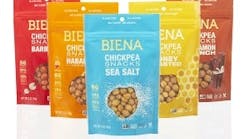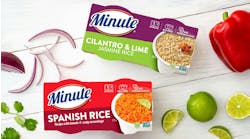The baby boomer generation is retiring, developing health ailments and becoming empty nesters, all of which is changing how they (should) eat and drink. While a slower metabolism and lower energy requirements might mean eating less, lower absorption and utilization of nutrients might actually mean nutrient requirements (particularly as a function of body mass) may increase.
Baby boomers have been a goldmine for product developers over the past decades, and they could continue to be if processors focus as many marketing efforts on them as they do millennials and others under the age of 35.
As a group, the boomer generation is still large and outsized compared with other generations. They're a lively segment, and their life expectancy is higher today than it was for earlier generations. Many pay a lot of attention to foods high in nutrients and low in saturated fat, cholesterol and sodium.
But the food industry generally has shied away from marketing products that single out or target aging consumers. "Rather, they focus on developing products [that meet the needs] common among older and younger generations, such as protein-fortified foods, because these align with promoting a healthy, active lifestyle and managing hunger and thus weight," observes Jean Heggie, strategic marketing lead at DuPont Nutrition & Health, St. Louis. The company's various soy protein ingredients promote lean muscle mass, heart health and address other aging issues.
While some boomers admit they're unhealthy, many try to fend off aging and understand that a healthy diet extends the active years, says Patrick Luchsinger, marketing manager-nutrition, for Ingredion Inc., Westchester, Ill., which makes Vitessence pulse protein ingredients. "They are more accepting of fortification and functional foods and look for products providing them to help stay healthier and active."
Dig In...
While Gatorade has had its ups and downs, the bigger sport/energy category continues to innovate with protein, hydration, electrolytes and whole-food ingredients. Learn more about what food processors are doing in the energy drinks space in our handy E-Handbook: Energy & Sports Foods and Beverages
Protein is generally something boomers and older adults can eat less of, especially in terms of meat, notes Tom Katen, technical service manager–meats, at Cargill Texturizing Solutions, Minneapolis. "As a result, they need more protein in concentrated form. At the same time, as the new Dietary Guidelines encourage, they need to limit saturated fat intake. Textured soy flour is one way for meat processors to address these nutritional challenges."
[pullquote]
Adds Luchsinger, "They want smaller package and serving sizes. They no longer have the family at home to feed, so don’t want food to spoil. Many have reached the empty-nest phase. That's why new food products in yogurt, bars, smoothies and snacks are in single serving sizes with functional claims that appeal to this generation."
The older set also prefers a value price, according to Chicago's IRI, as well as easy-to-read nutrition labeling and products for special dietary needs.
Boomers spend more of their grocery budget on health and wellness products than other generations, Luchsinger continues. "They generally plan to add more fiber, pre- and probiotics, protein, calcium, whole grains and vitamins to their diet and reduce consumption of red meat. They prefer products reducing 'unhealthy' items, such as those making low carb, trans fat-free, sugar-free and non-GMO [genetically modified organism] claims. There is an abundance of ingredients being used in new products marketed to this group, such as prebiotic fibers like short-chain fructooligosaccharides (scFOS) for digestive health, resistant starches for healthy blood glucose management from vegetable sources."
Packaged Facts, Rockville, Md., projects there will be a vibrant market for functional foods among boomers. "Marketers need to be cautious about assuming that the only foodies who count are millennials," points out research director David Sprinkle. According to the market research firm's report on Foodies in the U.S., boomers are just as likely as millennials to "usually only snack on" healthy foods and seek organic or natural foods when shopping for food. They mainly search for the freshest ingredients.
"Consumers don't want another pill to take," echoes Luchsinger. "They want nutrients and functionality of ingredients in a tasty and convenient food application that fits their lifestyle."
Functional foods for health optimization
Taking a close look at the hottest functional food ingredients headed into 2016, Packaged Facts reports plant proteins, microalgae, omega-3 fatty acids, vitamin D and magnesium will be high in demand as boomers want products offering positive nutrition to help them optimize health and avoid chronic and potentially life-threatening illnesses. And nearly a third of consumers indicate functional foods could replace some medicine in the context of their overall health approach.
Innova Market Insights identified the top five health claims for functional foods marketed to older consumers. Health optimization is both No. 1 and a good general description of the other four: digestive/gut health, energy/alertness, heart health and immune health. Aging well has widespread appeal among boomers, Innova says. The Netherlands-based market research firm also notes opportunities in age-related products include brain/cognitive health, bone health, skin health, joint health and eye health.
Foods incorporating polyphenols, Co-Q10, B vitamins and omega-3 fatty acids would figure prominently for good heart and cognitive health and confer anti-cancer benefits. These elements may be added to more products and categories as time goes on.
Products with anti-inflammatory formulations could be in demand as well, as more awareness of healthy aging surfaces, says Luchsinger. "There is certainly room for products that contain anti-inflammatory functionality. Inflammation is a cause of many serious disorders that can become more frequent after age 60." Ingredion's prebiotic fibers, including Nutraflora scFOS, have anti-inflammatory properties, as well as helping digestive and immune health.
Especially critical is the aging population's high risk of diabetes. A recent study published online by the Journal of the American Medical Association says nearly half of the adults in the U.S. have diabetes or pre-diabetes, the latter when a person already has elevated blood sugar and is at risk to develop the disease. With the recently issued Dietary Guidelines for American encouraging everyone to cut sugar intake to no more than 10 percent of daily calories, boomers should be looking for low- and no-sugar foods more than ever. Americans overall already are buying less sugar. In the biggest nosedive in four years, sugar consumption fell 4.4 percent through October 2015, according to Nielsen data, a drop grocers attribute to the growing consciousness of sugar's negative health effects.
Easy to eat
Kellogg has been redefining its ready-to-eat cereals with different formats aimed at older consumers, such as Kashi Heart to Heart Chia, Raisin Bran Omega-3 and Special K Multigrain.
Convenient, portion-controlled and ready-to-eat items are tops on boomers' shopping lists. Premade single-serve salads in bowls, such as the new elevĀte brand from Ready Pac Foods Inc., showcase ancient grains, berries, nuts, seeds and other healthy ingredients. Launched in November, the eight salad kits are said to be a first of their kind in the category, incorporating "superfoods" like chia seeds, goji berries, walnuts, kale, broccoli, almonds and blueberries, all containing many of the nutrients aging folks need. Plus, the ingredients are organic, gluten-free and non-GMO (genetically modified organisms).
Each salad can be mixed and eaten directly in the bowl. Ready Pac also offers bagged baby kale salad blends, which are rich in vitamin A, vitamin C and protein. Compartmented Bistro Bowl Salad Wrap kits feature fresh produce, artisan tortillas, protein and flavorful sauce.
With a portion control spin on a healthy snack, Mondelez International, Deerfield Ill., is launching a less-is-more version of its Wheat Thins crackers called Wheat Thins Even Thinner. Capitalizing on the success of Oreo Thins introduced last summer, the new Wheat Thins are 14 percent thinner, allowing snackers to eat 22 rather than 16 of the original Wheat Thins and get the same calorie count.
General Mills, Minneapolis, is unveiling several new products that align with the aging population's preferences and trends such as wellness, convenience and indulgence. Launched in January, the new entries include Yoplait Plenti Oatmeal Meets Greek Yogurt, Nature Valley Cereal, Cascadian Farm Organic Granola, Annie’s Yogurt and reformulated Nature Valley Crunchy bars that are easier to bite. Plenti is what General Mills calls reinvented Greek yogurt made more substantial with oats, fruit, and pumpkin and flax seeds. Available in six flavors, the nonfat yogurt has up to 180 calories per serving, 2g of fat, 2g of fiber, 12g of sugar and 11g of protein.
"Regardless of age, protein is a key nutritional component of the daily diet and is crucial from infancy, adolescence, adulthood and during aging," says Mark Cope, applied nutritionist manager at DuPont Nutrition & Health. "The strong interest in protein has followed an equally encouraged investigation of protein's role in support of blood sugar maintenance, heart, muscle and bone health." This is mirrored by a drop in daily protein consumption as we age, caused by a decreased appetite and a drop in energy expenditure, he says. Protein isn't stored in the body, so daily intake is needed.
The pulse on grain legumes
2016 has been dubbed the International Year of Pulses (beans, peas, lentils and chickpeas), by the United Nations and the Food and Agriculture Organization (FAO), as pulses offer high protein, vital amino acids and sustainability. For boomers, pulses provide plenty of fiber and vitamins and minerals, such as iron, zinc, folate and magnesium. They address obesity, and help manage and prevent chronic diseases such as diabetes, coronary conditions and cancer, according to the FAO.
As boomers search for foods that suit their health concerns, they want to amp up flavors. The Chickpea Snacks come in zesty flavors like Habanero, Honey Roasted, Cinnamon Crunch, Sea Salt and Barbeque. Biena's CEO/founder Poorvi Patodia started working with roasted chickpeas in 2012, and market distribution of the snack grew to nearly 4,000 outlets last year. "As the better-for-you snack world expands and people get more adventurous with their tastes, we want our flavorful snacks to stand out on the shelf," she says.
"Plant-based snacks are building market share," she continues. "We are just starting to leverage the many benefits of chickpeas and legumes. Boomers are an active generation by any standard and are looking for foods that support that lifestyle. They're fueling more active daily lives with diets higher in protein and fiber. We're at the tip of the iceberg in terms of bringing [legumes] to the broader population."
For more snacking, Snikiddy LLC, Boulder, Colo., offers eight flavors of Eat Your Vegetables chips featuring kale, broccoli, spinach, tomatoes, sweet potatoes, carrots and shiitake mushrooms. The company says the proprietary chips blend beans and brown rice with a serving of vegetables in every ounce. The gluten-free chips, in 4.5-oz. bags, are also a good source of protein, vitamins A, C, E, B1, B6 and antioxidants.
Capitalizing on the grain/veggie meal bowl trend, Grainful, Ithaca, N.Y., offers frozen dinner entrées that extend the oat category beyond breakfast. The meal options feature veggies and steel-cut oats, what Grainful describes as "the less processed sibling of rolled oats." Heart healthy and full of fiber and protein, the gluten-free meal bowls come in Porcini Mushroom Chicken, Thai Curry, Tuscan Bean & Kale, Unstuffed Pepper and Vegetarian Chili. Each 283g meal has 240-280 calories.
The aging consumer market is growing, but marketing to this demographic is tricky. Neither marketers nor the target consumers want to see "especially for older adults" as a package callout. "Companies hoping to grab a share of the mature market must position products on an ageless platform, rather than for the elderly," says Mintel.
Yet more than half of the 30,000 seniors questioned by New York-based Nielsen said promotions and advertising of new and trendy foods didn't reflect them or their needs. More research needs to be done on the group, Nielsen and others have discovered, and food manufacturers will pay the price of not understanding it.


